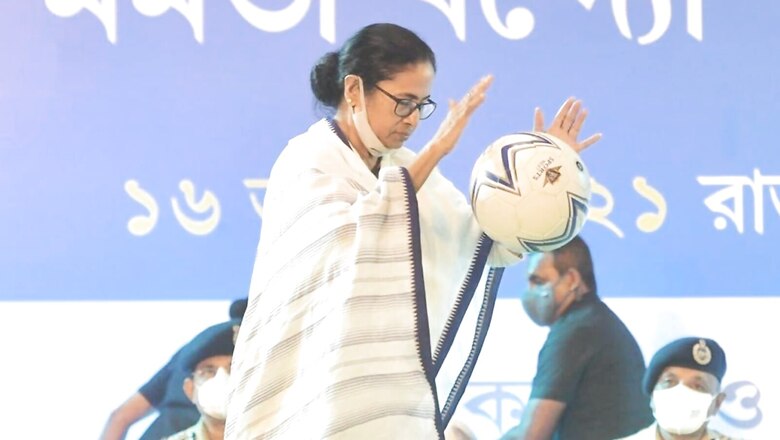
views
Faster, higher, stronger. That’s the usual motto of the Olympic games. Imagine the rush of competing with a hundred nations for a medal. We have just experienced the thrill of it, witnessing years of preparation come down to a single moment of reckoning; the anticipation, the triumphs and the heartbreaks. Now that our athletes have made the nation proud, state governments across the country are getting ready to shower them with rewards. States such as Haryana, Punjab, Assam or Odisha are set to lose a lot of money, and we couldn’t be happier.
In case you have not noticed, there is one state government that has made “khela hobe” its unofficial slogan. In fact, Mamata Banerjee is all set to observe a special “Khela Hobe Diwas” on August 16, when she will distribute footballs to kids all across the state. That is how seriously she takes this slogan. And yet, how ironic that they got left out of the discussion surrounding the Olympic games.
Before you tell me that “khela hobe” was not supposed to be taken literally, let me ask you this. What does “khela hobe” actually mean? It is set to be one of the biggest hit political slogans of the decade, yet what does it mean? Is there a promise implied by it, or even a hint of a promise? Does it suggest good governance, better infrastructure, jobs, education, wealth creation, anything at all? Let me put it this way. Five years later, when the TMC comes back to ask for votes, how are citizens supposed to assess the performance of the state government? By asking whether they have delivered on “khela hobe”?
That’s when you realise the mind trick behind the now-famous TMC slogan. It does not give a handle to citizens to hold their government accountable for anything. At best, it promises politics for the sake of politics. Those who are more familiar with the political idiom and history of Bengal will recognise the subtext. The boys are getting ready for a fight. But fighting for what, exactly?
Politicians do make promises all the time, and hold out all kinds of dreams. A handful of these are fulfilled, while most come up short. The public is already wise to this. It’s nothing new. What is new is that Mamata Banerjee won by promising nothing at all.
To be fair, there has to be an official TMC manifesto somewhere. But the fact that a brilliant political communicator like Mamata Banerjee would not put any of those promises, nor any hint of them into her campaign slogan tells you how she wants her voters to think. As she positions herself as a potential Prime Minister, we have to ask what the Bengal model has done for the people of the state and what it can do for the nation. Look at all the supposed demons that she says she is fighting against; Hindutva, RSS, Hindi imposition and so on. The BJP has not governed Bengal even for a day. By that account, Bengal should be a model state. Is it?
The latest state-wise GST collection figures are quite revealing. During the month of July 2021, West Bengal collected Rs 3,463 crore as GST. In the same time period, the neighbouring state of Odisha collected more than that, at Rs 3,615 crore. The population of Odisha is slightly less than half of the population of Bengal. Let us also account for the fact that West Bengal has a giant metropolis in Kolkata, which should drive up consumption. And Odisha isn’t even a traditionally rich state to begin with. How did West Bengal fall behind?
When I posed this question on social media the other day, I received a sorry mix of excuses, rationalisations, and outright abuse. People reminded me about Odisha’s vast mineral wealth. As it is, Bengal itself is quite rich in mineral resources. But more than that, what happened to Bengal’s famously developed human capital, which is always the biggest resource of all? And none of this accounts for why Odisha’s GST collections have slowly overtaken Bengal. Go back to December 2019 and you will see Odisha quite some distance behind. One particularly creative individual even blamed the British for shifting their capital out of Calcutta back in 1911, presumably to Odisha. It tells you everything about how successive regimes in Bengal over the years have conditioned people to think.
Recently, both Odisha and West Bengal were hit badly by Cyclone Yaas. When the Prime Minister arrived for a review meeting, the Odisha CM graciously welcomed him. But the Odisha CM said that he would not request any financial assistance, because the nation was already burdened with the pandemic. In contrast, the Bengal CM demanded a package of Rs 20,000 crore, met the Prime Minister for just 15 minutes, and left. Could there be an attitude problem because of which West Bengal is suffering?
We in Bengal have fallen behind. Why is that so hard to admit? What Bengal thinks today, India thinks tomorrow, they used to say. But that’s not true any more. Things that were true yesterday need not be true any longer today. Is that so surprising?
What model of growth does Bengal present before the nation today? What kind of investment or industry has the TMC government managed to attract to the state? In the last five or six years, mobile phone production has really taken off in our country, making India the second largest manufacturer in the world. How much of this industry has come to Bengal?
For the last four years in a row, Gujarat has been the number one destination for Foreign Direct Investment (FDI) in India. In the last financial year, Gujarat received 37 per cent of total FDI inflows to India, while West Bengal accounted for about 1 per cent. Put another way, Gujarat received 37 times as much foreign investment as West Bengal did.
There are of course a handful of social indicators, where West Bengal is slightly above average. And these are nowhere as encouraging as Indian liberals would have you believe. For instance, West Bengal is usually in close competition with Bihar for the number one position in child marriages. How is that something to be proud of?
Sure, there are some states which have been doing better with investment and job creation for a long time now. But what has the TMC government done to change all that about Bengal? As it is, for all intents and purposes, the TMC is already allied with every party that has ever ruled over West Bengal, both the CPI(M) and the Congress. Who do they blame for the collapse of industry and investment in Bengal? Certainly not the British. When they left, Bengal was the most industrialised state in India.
When Gujarat CM Narendra Modi began building his national profile, he started the Vibrant Gujarat summit. The current West Bengal CM has started “Khela Hobe Diwas.” That says it all, really.
So what exactly is the Bengal model? Is it just consolidation of minority votes? Is it just political violence, which does not officially happen, because the state does not record anything and the local media is scared to report anything?
From the day of Narendra Modi’s election in 2002 to the day he stepped down as CM to become Prime Minister of India, there was no curfew for even a day in a single police station area in Gujarat. In contrast, even the most loyal supporters of the Bengal CM will not dare speak highly of the law and order situation in her state. The scary part is that our liberal secular class does not even want to discuss these questions, whether law and order, industry or investment. Just “khela hobe”, whatever that is supposed to mean.
I understand that Bengal occupies a special place in the imagination of our liberal and secular classes. Here is a state that has never had a BJP government, nor has any ruling party in West Bengal ever allied with the BJP. And that means the TMC government gets a pass on everything. That only means more excuses, more accusations of “stepmotherly treatment” from the government in Delhi, and more rants against the people of Bihar and Uttar Pradesh. And accusing others of not having enough respect for our glorious past.
Let me end with an Olympic story. Did you know that India did not lose a single hockey game at the Olympics between 1928 and 1960? Then, we fell behind. Now we are getting back on our feet. For that, we had to first admit that something had gone wrong and then we had to fix it. Was there any other way?
Abhishek Banerjee is a mathematician, columnist and author. The views expressed in this article are those of the author and do not represent the stand of this publication.
Read all the Latest News, Breaking News and Coronavirus News here.













Comments
0 comment